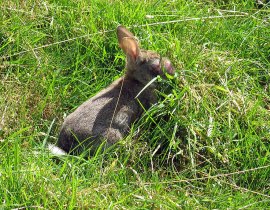Professional Pest Control & Wildlife Management
Myxomatosis
* The following information was taken from RWAFs website on Understanding Myxomatosis…
What is myxomatosis?
Myxomatosis is a severe viral disease of rabbits that decimated the wild rabbit population when it arrived in Britain 50 years ago. Domestic rabbits are also susceptible to the disease and deaths in pets are reported every year.
The number and severity of outbreaks varies over time: the myxomatosis virus is notorious for its ability to mutate from year to year and the background immunity in the wild rabbit population also varies. For example, in autumn 2000, southern areas of the UK (the south west, Hampshire, Suffolk, Cambridgeshire) experienced a severe outbreak of myxomatosis, thought to have been caused by a particularly virulent strain of the myxomatosis virus.
Is my rabbit at risk?
Myxomatosis poses a threat to all pet rabbits but the risk varies depending on whether your rabbit lives inside or outside.
Pet rabbits at greatest risk are those living outside, especially if they may have any contact with wild rabbits or hares. Pet rabbits affected by rabbit fleas are also at very high risk – rabbit owners who also have a dog or cat that hunts wild rabbits (or foxes that visit the garden and nose around rabbit hutches) must be particularly careful, in case rabbit fleas are brought back to the pet bunny.
House-rabbits living permanently indoors are at less risk than outdoor rabbits, but can and do get myxomatosis. They must be vaccinated and protected from possible sources of myxomatosis transmission too.
How is it spread?
Myxi is usually spread by biting insects (fleas, mosquitoes) carrying the Myxoma virus. However, direct rabbit-to-rabbit spread can occur. Previously, this was mainly seen in a French respiratory strain of the disease, but reports from the Autumn 2000 UK outbreak suggest that rabbit-to-rabbit transmission may now occur the UK.
Pet rabbits could contract myxomatosis in a variety of ways:
- Bites from mosquitoes carrying the Myxoma virus.
- Bites from fleas carrying the Myxoma virus (fleas can survive for many months in hay)
- Myxomatosis can also be spread by Cheyletiella fur mites
What happens when a rabbit catches myxomatosis?
The classic form of myxomatosis is seen in rabbits that haven’t been vaccinated. It is a dreadful disease that causes immense suffering: affected rabbits can take a fortnight to die and treatment is usually futile, which is why euthanasia is usually recommended.
Classic myxomatosis starts with runny eyes and in the very early stages can be confused with other causes of conjunctivitis. However, myxomatosis differs as the genitals are also swollen. It rapidly progresses to a severe conjunctivitis which causes blindness and is accompanied by lumpy (nodular) swellings on the head, plus lumps on the body. Excessive amounts of thick pus discharges from the nose and swollen eyes (which are often sealed shut). There are also two atypical forms of myxomatosis: one causes pneumonia and a snuffles-like illness; the other (“Nodular myxomatosis”) mainly affects skin and carries a better prognosis.
If a vaccinated rabbit develops myxomatosis, the disease is usually much less severe. The exact pattern of disease seen in vaccinated animals is very variable, and impossible to predict: it depends upon how much immunity the rabbit has. Some rabbits develop just a few odd skin lesions and remain otherwise well; others become quite poorly and suffer from swellings and conjunctivitis more like classical myxomatosis. The difference is that vaccination turns a fatal illness into one that is treatable.
What about myxomatosis vaccination?
Domestic rabbits do not have any genetically based immunity against myxomatosis. If an unvaccinated pet rabbit catches myxomatosis, it will almost certainly die. Vaccination is a vital part of a package of measures you can take to protect your rabbit and the RWA urges all rabbit owners to make sure their rabbit is vaccinated with a licensed veterinary product and boosters are kept up to date.
The myxomatosis vaccine in Britain (Nobi-vac Myxo) is made from a harmless virus called Shope Fibroma. Antibodies made in response to Shope Fibroma Virus also protect against myxomatosis – this is called cross immunity. Different vaccines (including live attenuated myxomatosis virus) are used elsewhere in Europe, but tend to have more side effects and there are concerns that they are not safe enough for use in pet rabbits.
Different vaccines (including live attenuated myxomatosis virus) are used elsewhere in Europe, but tend to have more side effects and there are concerns that they are not safe enough for use in pet rabbits.
“High risk” areas typically include:
- Anywhere near standing water or a with large mosquito population
- Areas affected by outbreaks of myxomatosis in wild or domestic rabbits.
If you hear of a myxi outbreak in your vicinity, it would be wise to ensure your bunny has been vaccinated within the previous 6 months: take him for an early booster if necessary.
We would advise when vaccinating to vaccinate 2 weeks apart from the VHD vaccine.
Vaccination can start from as young as 6 weeks of age, but only healthy rabbits should be vaccinated and the vaccine can’t be administered to pregnant animals.
Even if your rabbit is vaccinated, you must also take steps to prevent biting insects getting to your rabbit.
- Try to buy hay from farms free of myxomatosis
- Fit insect screens to outdoor hutches and runs
- Eliminate standing water from your garden (and preferably from any neighbouring gardens as well!) where mosquitoes could breed.
- Be especially careful if you have a dog or cat that hunts wild rabbits, as they could bring rabbit fleas home on their noses! It wouldn’t hurt to treat them as a prophylactically anyway!
- Make sure that rabbits living outdoors cannot make contact with wild rabbits or hares.
- If your rabbit has any signs of Cheyletiella fur mites (e.g. dandruff on the back of the neck, take him to the vet for prompt treatment.
Special points about the myxi vaccine
Most vaccines are given entirely subcutaneously (under the skin), but the myxomatosis vaccine is different.
About a tenth of the dose has to be givenintradermally – into the layers of the skin – for adequate immunity to be achieved. Some vets give it into the thicker skin at the base of the ear; others on the way in or out of the skin at the scruff of the neck. Although fiddly, the intradermal part of the injection is absolutely vital to stimulate an immune response in the skin, which is where the myxomatosis virus usually gains entry to the rabbit.
If you are involved with a rescue centre where the vet allows lay personnel to vaccinate the rabbits, please double check the correct technique is being used. If your own rabbit is being vaccinated, double check that the vet remembers the intradermal bit!
Intervet (the vaccine manufacturer) need to know about any cases where vaccinated rabbits develop myxi. They are extremely approachable and willing to help with any queries about their product. Your vet should liase with them to ensure they are fully briefed about the nature and severity of disease suffered by the affected animal.
Can rabbits with myxomatosis be treated?
If an unvaccinated rabbit catches myxomatosis and develops the full-blown classic form of the disease, survival is very unusual, even with intensive nursing and treatment with antibiotics to prevent secondary bacterial infection. Most affected pets in this situation are put to sleep as soon as the diagnosis is made, to prevent futile suffering.
If a vaccinated rabbit is unlucky enough to catch myxomatosis, the situation is much less gloomy. How severely any one vaccinated rabbit will be affected is impossible to predict. It depends on how much immunity they developed after their vaccination. Some rabbits simply develop a single skin lump and remain perfectly well. A few become really poorly. Others fall somewhere in between, such as being a bit “off colour” with a few skin lesions.
Treatment is usually successful in the vaccinated rabbit with a good vet, nursing care and a bit of luck. But it if the rabbit is unlucky enough to be badly affected, intensive and prolonged veterinary and nursing care (weeks rather than days) is occasionally required.
Rabbits being treated for myxomatosis need:
- Careful nursing care in a warm environment (21-22 degrees centigrade)
- Regular bathing of sticky eyes and genitalia
- Fluid therapy – subcutaneous, intra-peritoneal or intravenous fluids may be used
- Tempting food and syringe or tube feeding if necessary
- Antibiotics to prevent secondary bacterial infection
This doesn’t make vaccination a waste of time – far from it. Rabbits that have not been vaccinated will almost certainly die if they catch myxomatosis…. rabbits that have been vaccinated usually live to tell the tale if they catch it.
If you know anyone with a pet rabbit, please do tell them about the importance of vaccination against both VHD and myxomatosis, as well as insect proofing measures.
Currently the RWF is funding a project investigating the vectors and transmission of myxomatosis, any donations to help with future such projects would be gratefully received.
- False Widow Spider Removal
- Cluster Fly help
- The trouble with fleas?
- Mole Catching in Suffolk
- Rats in the Garden
- Wasp Nest Control
- Rats in your chicken Coop
- Anaphylaxis
- Bee Swarms
- Becoming a Beekeeper
- Rare Breed Poultry
- Pest Control with Birds of Prey
- Un-marked vehicles available
- Rabbiting with Ferrets
- Myxomatosis
- Poll-Tex Mesh
- Honorary Member Russell Wallis
- Free Rabbit Control


